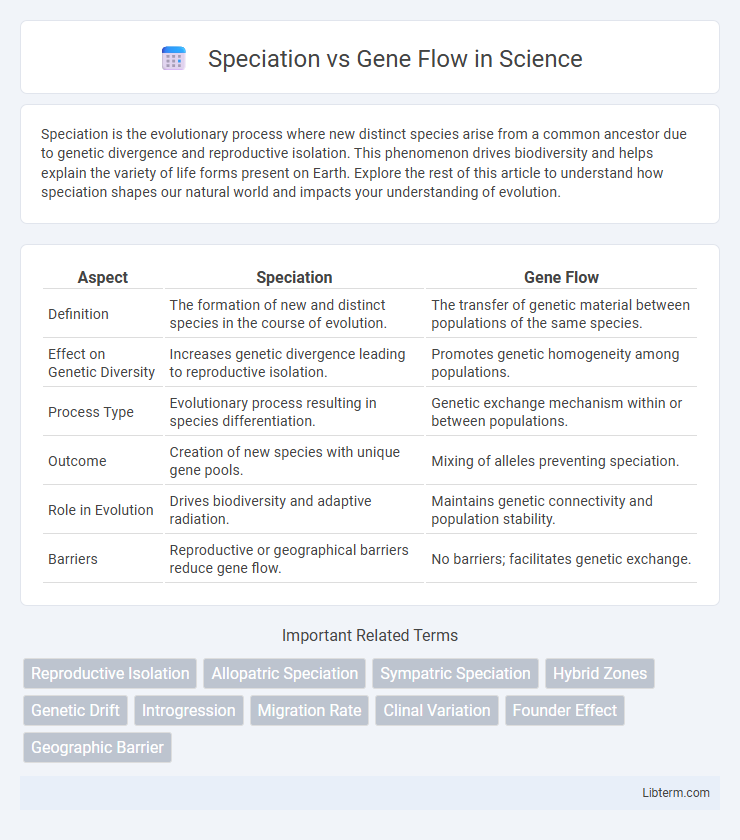Speciation is the evolutionary process where new distinct species arise from a common ancestor due to genetic divergence and reproductive isolation. This phenomenon drives biodiversity and helps explain the variety of life forms present on Earth. Explore the rest of this article to understand how speciation shapes our natural world and impacts your understanding of evolution.
Table of Comparison
| Aspect | Speciation | Gene Flow |
|---|---|---|
| Definition | The formation of new and distinct species in the course of evolution. | The transfer of genetic material between populations of the same species. |
| Effect on Genetic Diversity | Increases genetic divergence leading to reproductive isolation. | Promotes genetic homogeneity among populations. |
| Process Type | Evolutionary process resulting in species differentiation. | Genetic exchange mechanism within or between populations. |
| Outcome | Creation of new species with unique gene pools. | Mixing of alleles preventing speciation. |
| Role in Evolution | Drives biodiversity and adaptive radiation. | Maintains genetic connectivity and population stability. |
| Barriers | Reproductive or geographical barriers reduce gene flow. | No barriers; facilitates genetic exchange. |
Introduction to Speciation and Gene Flow
Speciation occurs when populations of a species diverge genetically to the point that they become reproductively isolated, leading to the formation of new species. Gene flow refers to the transfer of genetic material between populations through migration and interbreeding, which can counteract divergence by homogenizing genetic differences. Understanding the balance between speciation and gene flow is crucial for studying evolutionary processes and biodiversity patterns.
Defining Speciation: Process and Types
Speciation is the evolutionary process by which populations evolve to become distinct species, primarily driven by genetic divergence and reproductive isolation. This process occurs through various types, including allopatric speciation, where geographic barriers separate populations, sympatric speciation, involving genetic divergence without physical separation, and parapatric speciation, occurring in adjacent populations with limited gene flow. Gene flow acts as a critical factor influencing speciation by either homogenizing genetic differences between populations or facilitating the emergence of reproductive isolation when disrupted.
Understanding Gene Flow: Mechanisms and Importance
Gene flow occurs when alleles are transferred between populations through migration, mating, or dispersal, promoting genetic diversity and reducing differentiation. This genetic exchange counteracts speciation by homogenizing gene pools and preventing reproductive isolation. Understanding gene flow mechanisms is crucial for studying population structure, evolutionary processes, and conservation genetics.
The Relationship Between Speciation and Gene Flow
Speciation occurs when populations diverge genetically to the point of reproductive isolation, while gene flow acts as a homogenizing force by exchanging alleles between populations. High levels of gene flow can prevent speciation by maintaining genetic similarity, whereas reduced gene flow allows genetic divergence and the formation of new species. The balance between gene flow and isolation influences evolutionary paths and biodiversity within ecosystems.
Barriers to Gene Flow in the Speciation Process
Barriers to gene flow, such as geographic isolation, behavioral differences, and genetic incompatibilities, play a crucial role in the speciation process by preventing interbreeding between populations. These reproductive barriers reduce or eliminate gene exchange, allowing populations to accumulate distinct genetic variations and adapt to their specific environments. Over time, this genetic divergence leads to the emergence of new species through mechanisms such as allopatric, sympatric, or parapatric speciation.
Roles of Geographic Isolation in Speciation
Geographic isolation disrupts gene flow by physically separating populations, leading to reproductive isolation and genetic divergence necessary for speciation. In allopatric speciation, barriers like mountains or rivers prevent gene exchange, allowing distinct evolutionary paths through mutation, natural selection, and genetic drift. Over time, these isolated populations accumulate enough differences to form new species, highlighting the critical role of geographic isolation in driving biodiversity.
Genetic Divergence: How Populations Evolve
Genetic divergence occurs when populations accumulate distinct genetic differences due to limited gene flow, leading to speciation. Reduced gene flow restricts the exchange of alleles, allowing genetic drift and natural selection to drive evolutionary changes independently in isolated populations. Over time, these genetic variations result in reproductive barriers and the emergence of new species.
Hybrid Zones and Their Evolutionary Significance
Hybrid zones, regions where distinct species interbreed, play a crucial role in understanding speciation and gene flow by revealing how genetic exchange impacts species boundaries. These zones serve as natural laboratories for studying the balance between reproductive isolation and gene flow, influencing the evolutionary trajectory of diverging populations. The persistence or breakdown of hybrid zones informs the mechanisms driving speciation, adaptive divergence, and genetic diversity within and between species.
Real-World Examples: Speciation and Gene Flow in Nature
Speciation occurs when populations become reproductively isolated, as seen in Darwin's finches on the Galapagos Islands, where geographic barriers led to diverse beak shapes adapted to different food sources. Gene flow maintains genetic connectivity in widespread species like the North American gray wolf, where interbreeding between packs prevents genetic divergence. Studying these natural examples highlights how speciation and gene flow shape biodiversity through isolation and genetic exchange.
Implications for Biodiversity and Conservation
Speciation drives the formation of new species, increasing biodiversity by promoting genetic divergence within populations, while gene flow counteracts this process by homogenizing genetic differences and maintaining genetic connectivity. High gene flow can reduce speciation rates, potentially limiting adaptive diversity and resilience in ecosystems, which poses challenges for conservation strategies aiming to preserve unique genetic lineages. Effective biodiversity conservation requires balancing the preservation of gene flow to maintain healthy populations with the protection of isolated habitats that foster speciation and endemic species.
Speciation Infographic

 libterm.com
libterm.com